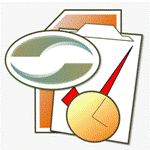Reclaim Your Day | 7 Ways to Reduce Wasted Effort Using Lean
Summary
- The Lean method of Value Stream Mapping (VSM) can be applied to personal productivity
- Non Value Added (NVA) activities can be summarized and remembered using the mnemonic TIMWOOD
- Remove NVA activities by reducing & processing your collection points, traveling in a straight line, using mobile technologies, being concise in what you deliver, remembering balance, and doing it right the first time.
- Recognize your accountability for how you spend your day and then you can learn how to do it better.
VSM for Personal Productivity. A colleague, Wally Davis [Blog], and I recently delivered training where we talked about Value Stream Mapping. I began wondering about how to apply those same techniques to help myself be more productive.
TIMWOOD. At Ceptara, we have an acronym that we use to help people remember what constitutes a non-value add activity in the value stream, TIMWOOD. It stands for:
- (T) Transportation - work moves
- (I) Inventory - work sits
- (M) Motion - people move
- (W) Waiting - people sit
- (O) Over-processing - adding 'value' the customer won't pay for
- (O) Over-production - doing or making too much
- (D) Defects - cost of doing it wrong, e.g. re-work, inspection, explanation, throw-away
Transportation
For many folks including myself, work piles up in any number of places. For example, mail collects on the counter and tables in the kitchen, the desk by the backdoor, and on the shelf between the family room and kitchen. Work from my briefcase, notes collected at meetings, and other reminders of todos pile up on my desk, on my file cabinet and on my floor. And everytime the surface would be cleared, those papers would move, and quite probably get lost or forgotten.
I have one collection point for any 'paper' that requires my attention - an inbox in my home office. There is literally a container that has been fastened to the wall that collects anything I need to do something with or my wife wants me to look at. It collects bills, work related mail, the kids announcements, and any other message to be 'processed'. If it's not in the box, I don't look at it. The work moves once and has a specific place to be processed.
In the digital world, this can be applied to the movement of messages. For example, an attitude of 'one and done' should prevail on electronic messages. Having a conversation in email beyond a few messages can turn into a large waste of time - pick up the phone or schedule a time dedicated to discuss the topic. All concerned folks will be focused and will get much more accomplished versus trying to shift gears everytime a new email pops in that grabs your attention.
Inventory
Anything waiting for your attention can be thought of as inventory, so it's very important to process your collection points. Processing does not mean moving things around, processing requires that you make decisions regarding your inventory. Restacking a pile, or marking an email message as unread and letting it sit in your inbox is not processing. We use the 5 Ds to help with processing.
- Do it - Execute it now
- Delete it - Throw it away
- Delegate it - Ask someone else to do it
- Defer it - Put it in a Trusted Management System (TMS) that will remind you to do it later
- Put it in a Drawer - Store it away for future reference
I spend a bit more time explaining this concept in the article about High Performing People, and we have a workshop that teaches people specific techniques in using the 5Ds along with a companion Outlook Add-in.
Motion
Reducing the amount of travel and maximizing the productive time while in a specific location through mobile technologies helps to maximize productivity while in motion. As a consultant, I have clients in several different geographies so to minimize travel time and impact on the planet, and maximize my fuel investment, I try to coordinate my meetings so that I'm traveling the fewest miles. And if I'm in between meetings, I don't go back to office, I find the nearest free WiFi location (usually Tully's Coffee - love these guys or Starbucks - use a SBUX card and get 2 free hours) and do work there. In an office environment, this can be done by coordinating meeting locations to minimize travel time and/or having meetings in specific blocks of time to minimize the time that you're away from the office. Of course, if going to meetings is part of your exercise routine, then nevermind.
Waiting
We covered the larger blocks of time in the previous section (Motion), i.e. mobile technologies can help you stay productive when you're away from your main office. But what about those 10 minutes in between appointments, or standing and waiting at the airport?
It'd be difficult to get out your laptop and even if you could, it's nearly impossible to be focused and productive in a small window of time. I like to use that time for processing and planning. I use task lists very heavily - it's my TMS, Trusted Management System. And since my mobile phone has a sync'd copy of my task lists and has my digital collection point (E-Mail), I can process email, move tasks, and schedule time on my calendar to accomplish work in those lost pockets of time. One quick note on Social Networking, i.e. Facebook, Twitter, LinkedIn to name a few. Don't be lured into those sites when you have small windows of downtime - have a purpose for those sites and plan time-blocks for their management. If you don't, these new technologies can be a vast wasteland of lost productivity.
Over-Processing
Over-Processing refers to adding value that the customer is unwilling to pay for. It's important to understand the value you're delivering and to whom. Since we're all delivering something different, I'm going to think about this from an Knowledge Worker view. The watch phrase for over-processing knowledge is "Be Concise". There's a reason CNN summarizes their articles at the top of the page. People don't take the time to read, they want to know that the words they're reading can help them with their objectives or is interesting in the moment. If not, they move on. Whether you're writing an article, blog post or email, your point needs to be made in the first three lines. If you can make an argument or deliver knowledge in fewer words, do it.
Over-Production
Is it possible for a person to over produce? I'm sure there are many managers that would say, "No way, we're looking for people who give 150%." The trouble with that statement is people can't give 150% all the time, any more then they can sprint a marathon. That's why balance is very important. But what is balance? To me, balance is recognizing that I have 100% of myself to give on any day to all that is important to me. That includes my family, my job, my community and myself. And I should make sure my goals, projects, tasks, and how I spend every minute aligns with who I am and why I'm here. When I produce a deliverable, I want to do the best job I can while remembering my balance.
Defects
The cost of doing it wrong. There is no doubt that mistakes are painful and often result in even more work. We all avoid them at (almost) all costs. Usually with preparation, attention to detail, and careful execution we can avoid most mistakes. In the spirit of Lean, we want to 'always' do it right the first time, however, that attitude could result in execution paralysis and stifle the innovative spirit. Consequently, the word balance jumps to mind again. Or if you prefer managed risk.
Conclusion
TIMWOOD has a number of useful directives that can help us get more out of our days. But like every productivity enhancing method, it is not the cure-all for lost productivity and damaged focus. We are accountable for ourselves and our time and it's the journey of understanding how we work that is most valuable.
- Chris's blog
- Login or register to post comments
-

 Printer-friendly version
Printer-friendly version Post to Twitter
Post to Twitter- Send by email
- PDF version
Recent Updates
Microsoft Outlook Add-In

Focus on Your Life, Not Your Inbox
Achieve greater focus by shifting your attention from e-mail to accomplishing what matters most!
Company News
Stay up to date with our newsletter!



